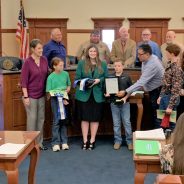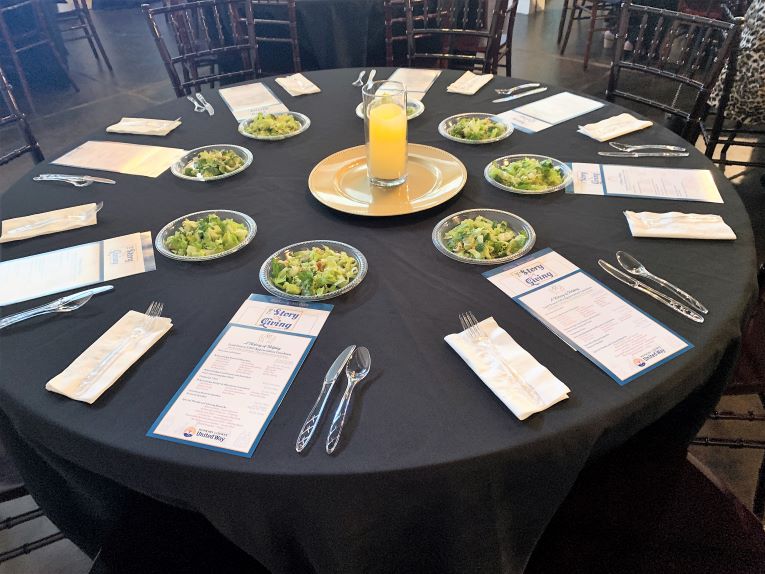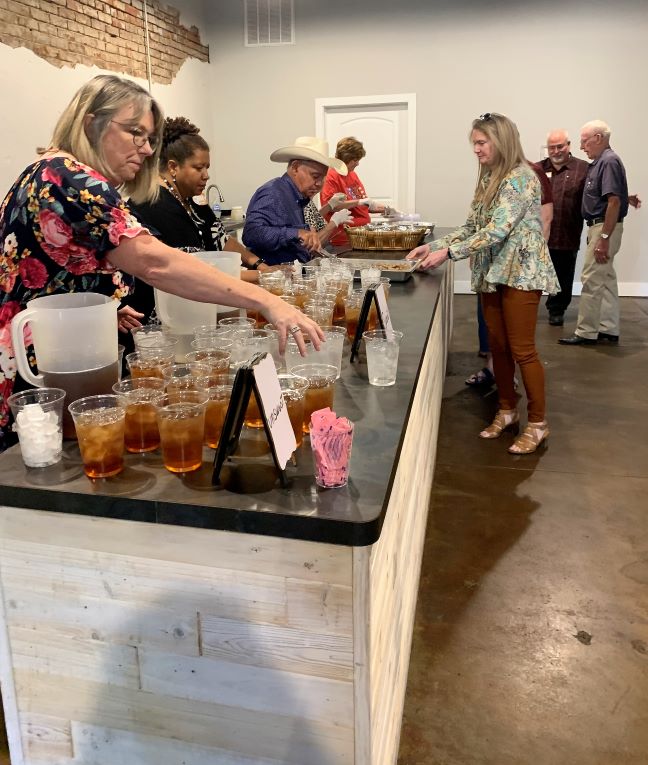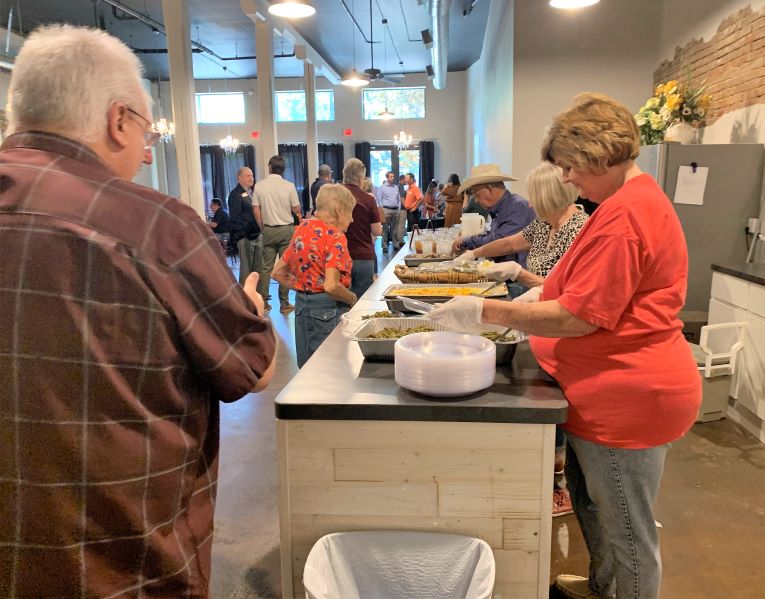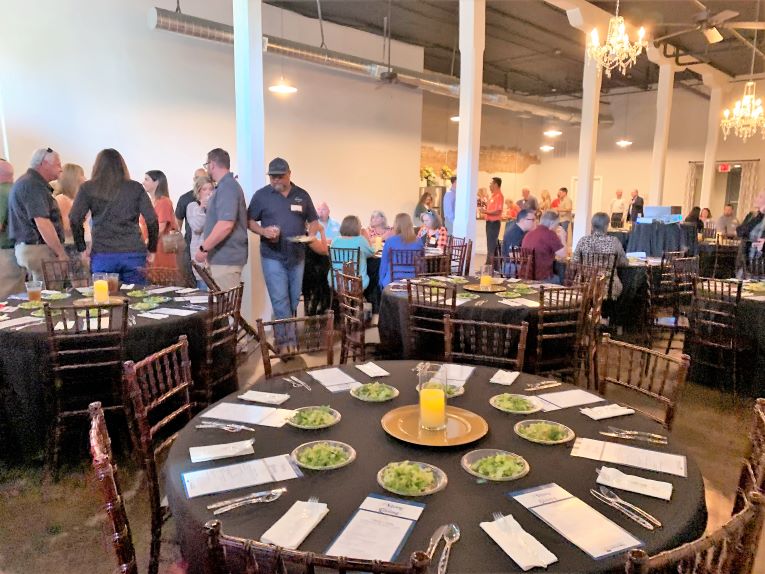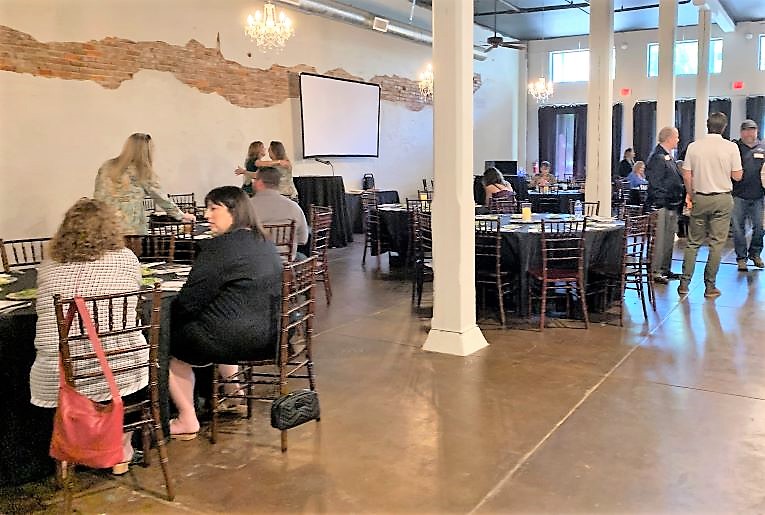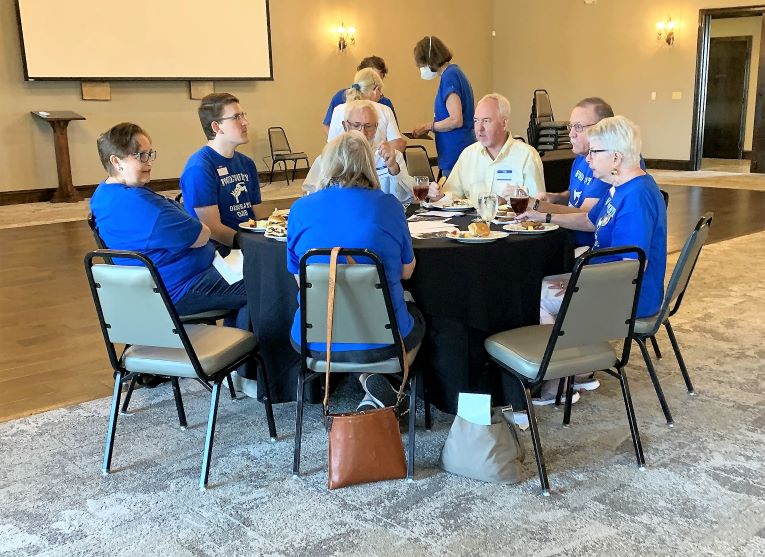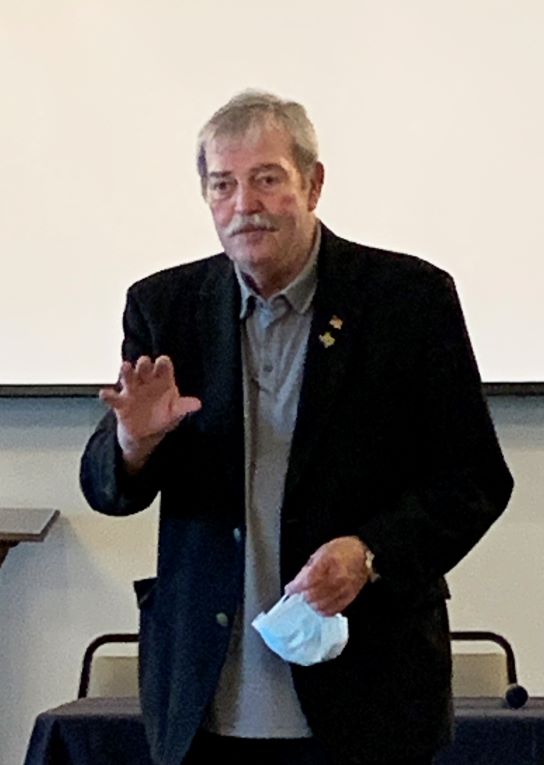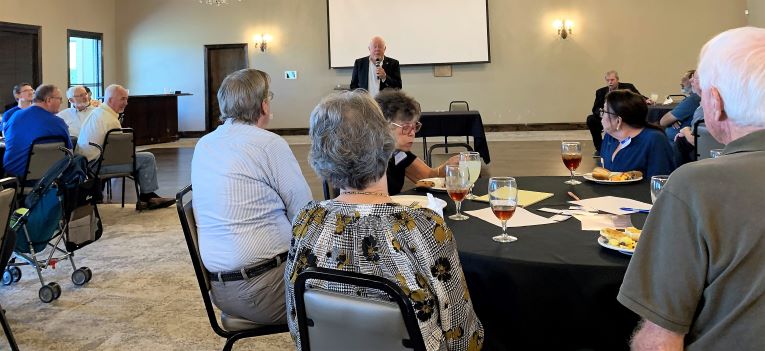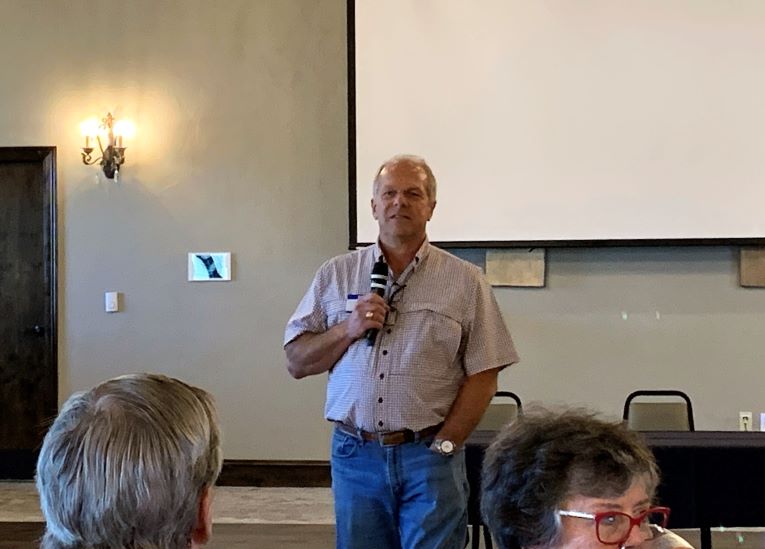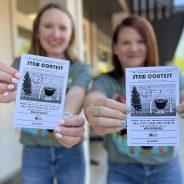Celebrating Youth Achievement For 4-H Week
Hopkins County AgriLife Extension Agents utilized their regular report to Hopkins County Commissioners Court to celebrate youth achievement in anticipation of the upcoming National 4-H Week, and noted some upcoming 4-H and Extension activities.
Johanna Hicks, family and community health agent, and Mario Villarino, agriculture and natural resources agent, gave an update on the 4-H program as well as upcoming activities planned as part of 4-H Week and presented awards and recognitions to four 4-H members for wins at the district level. Court officials also officially proclaimed the observation of Oct. 2-8, 2022, as National 4-H Week in Hopkins County.
National 4-H Week
Hopkins County Judge Robert Newsom, during Monday’s meeting, read a proclamation officially designating Oct. 2-8, 2022, as National 4-H Week in Hopkins County, and encouraged others to become involved with the 4-H program.
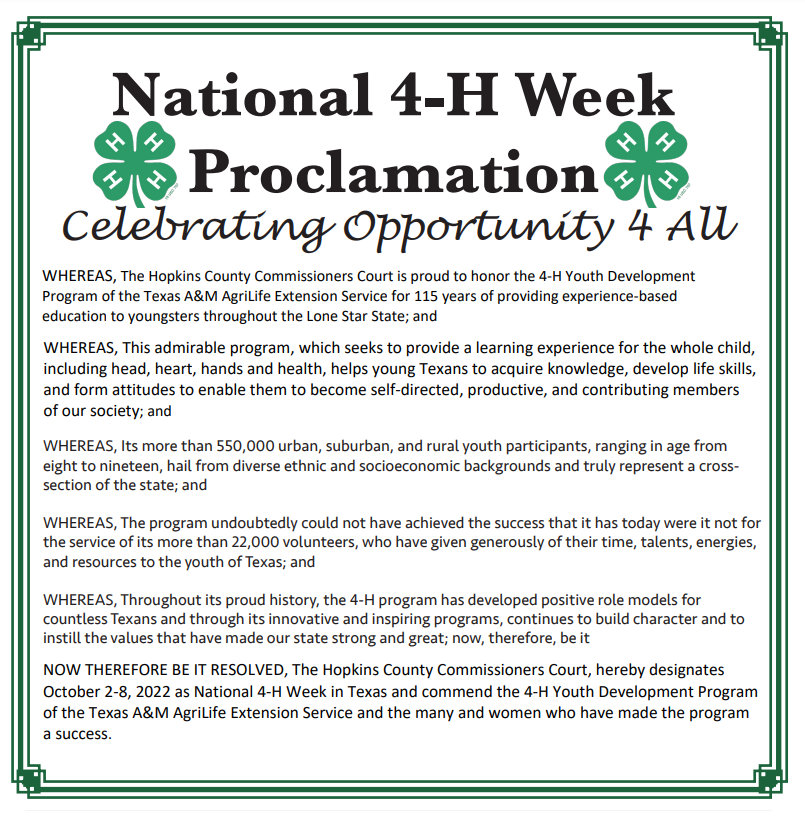
4-H, the nation’s largest youth development and empowerment organization, cultivates confident kids who tackle the issues that matter most in their communities right now. In the United States, 4-H programs empower 6 million young people through the 110 land-grant universities and Cooperative Extension in more than 3,000 local offices serving every county and parish in the country.
Outside the United States, independent, country-led 4-H organizations empower one million young people in more than 50 countries. National 4-H Council is the private sector, non-profit partner of the Cooperative Extension System and 4-H National Headquarters located at the National Institute of Food and Agriculture (NIFA) within the United States Department of Agriculture (USDA).
In Hopkins County, more than 200 4-H youth and 15 volunteers from the community were involved during the 2021-2022 4-H year.
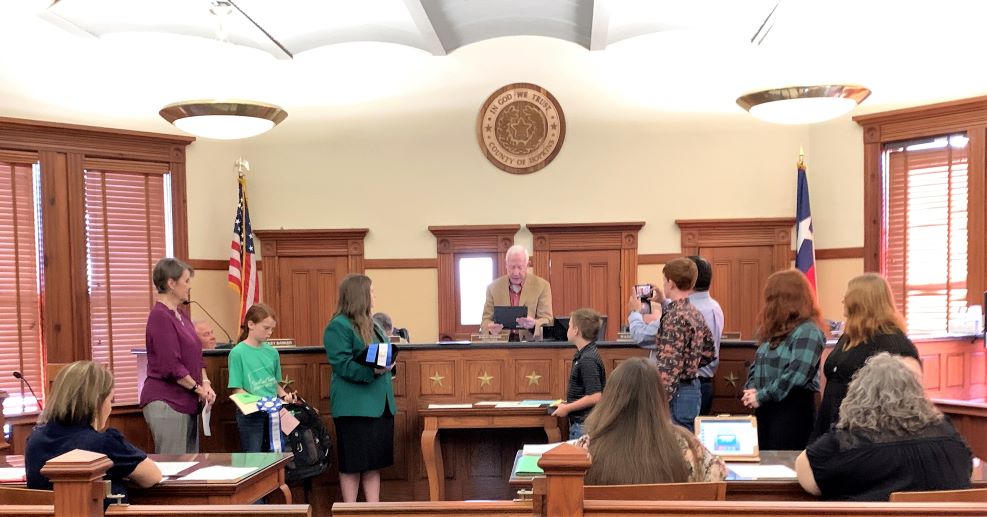
“The theme of this year’s National 4-H Week is Opportunity 4 All, which highlights how 4-H offers opportunity for youth to find their passion and explore learning about that passion and what lies within it through hands-on learning experiences. The positive environment provided by 4-H mentors ensures that kids in every county in the country — from urban neighborhoods to suburban schoolyards to rural farming communities — are encouraged to take on proactive leadership roles and are empowered with the skills to lead in life and career,” Hicks noted.
Hopkins County 4-H members plan to observe National 4-H Week by showcasing the incredible experiences that 4-H offers young people, and highlighting the remarkable 4-H youth in our community who work each day to make a positive impact on those around them.
Youth Recognition
Rylie Carroll was recognized for her first place win at the district level in the senior record book in public speaking. She also earned first place honors at state in the senior record book category. In addition to ribbons, Carroll also received a bag

Bryce McCool won first place honors in junior level archery competition, for which the youth received a belt buckle.
Kallie Mabe won fist place honors at district in junior level record book. The 4-H member received a first year 4-H pin, a project pin for an entomology project, a certificate for dairy and swine projects and was recently recognized at the 4-H Banquet as the Rookie of the Year.
Rounding out the list of award recipients was Kaden Mabe, for his second place finish at district for his record book. He received a Clover Star Award for 5 years of involvement in 4-H, a swine project pin, and a certificate for his 4-H diary and swine projects.
The County 4-H Council members too were recognized during the regular Sept. 26, 2022, Hopkins County Commissioners Court session.
Upcoming 4-H Activities
To officially kick off 4-H Week, Hopkins County 4-H Council will meet after school at the start of the week at the Extension Office to raise the 4-H flag.
County 4-H Project Show entries will also be accepted Oct. 3-6, judged on Oct. 7, and displayed Oct. 10-15. Many entries will also be entered in the Fall Festival Creative Arts Contest youth division.

Because giving back to the community is such an important component of the 4-H program, Hopkins County 4-H has partnered with the Sulphur Springs Middle School Communities in Schools program to collect items needed to assist students, Hicks and Villarino noted.
"Communities In Schools (CIS) is an organization that works on school campuses to help students overcome obstacles that interfere with them being successful at school. CIS helps students with things such as basic needs that can include clothing, school supplies, hygiene items, etc. and also connects them with community resources to help meet their needs. We help connect students with vision and other health providers, as well as mental health/counseling services. "CIS also helps students who are struggling in any way to get back on track by giving them one-on-one guidance and support. CIS will also work with the school/ counselors to develop school wide activities and events that will address subjects such as bullying, college and career awareness, or personal safety topics for which all students will have the opportunity to participate," Lauren Olvera, Communities In Schools Youth Services Coordinator, stated in a letter addressed to parents of campus students.
Among the items 4-H that will be accepting for the Communities in School program at SSMS are:
- body wash or bar soap,
- deodorant,
- leggings,
- spandex shorts,
- joggers,
- underwear and
- socks.
Donations for the Middle School CIS program will be accepted at the County Extension Office on Houston Street during the entire month of October. For a full list of items or addition information about the 4-H service project, contact the Hopkins County Texas A&M AgriLife Extension Office at 903-885-3443.
To learn more about 4-H in Hopkins County, call the local Texas AgriLife Extension office at 903-885-3443.
Lady Cat Golf Finishes Two Strokes Back of First in Fall Opener

Monday, Sept. 26 had Lady Cat golf in Mount Pleasant for their fall opener.
Sulphur Springs has just three competitions during the first semester, but even so, Coach Whitney Spigener and her squad made their opportunities count Monday, as they finished just two strokes back of host Mount Pleasant.
“All the girls… they competed hard and played well,” the Lady Cat golf coach said following the victory.
At their first competition of three this fall, Sulphur Springs headed to a familiar course in Mount Pleasant CC. Coach Spigener said she wanted to hit the links immediately since Monday’s competition sight is the same place Lady Cat golf is playing for the district championship come springtime.
An overall experienced squad who went to Regionals this past spring has bigger goals this go-round, but Lady Cat golf still showed up and showed out in their first competition of the 2022-23 school year.
Mykylie Meador, a senior for this squad, shot an 85 Monday.
A freshman, Evie Birdsong, tied Meador at 3rd by shooting an 85 in her first varsity competition. In a scorecard playoff between the two Lady Cats, Meador edged out the freshman by one stroke. Kenzie Posey, a sophomore, shot an 88 and continues to be a valuable contributor to this team. Another second-year member of Coach Spigener’s squad, McKenna Meskimen, ended up with 95 Monday.
All three of the previously listed scores are personal records for the Lady Cat golfers.

Allison Thomas shot a 91 and Autumn Allen had a score of 98. Allie Crump rounded out Sulphur Springs golfers Monday with a 116.
Coach Whitney Spigener in her eighth year coaching Sulphur Springs, Lady Cat golf has never had a team score as low as it was Monday.
“We have a few things that we could tweak, and we would’ve been right there in first place,” the golf coach said. “So this is a huge step up, starting out this year (like this). We have big goals moving down to 4A this year.”
Next up, both Wildcat and Lady Cat golf host their second competitions at Sulphur Springs Country Club on Monday, Oct. 17. A loaded competition sees most if not all of golf’s district foes, sprinkled in with a few foes Sulphur Springs may see if they make Regionals come springtime.
“It’s completely full, we’ve had to turn some teams away,” Coach Spigener said. “We’re looking at all of, if not all off our district competitions and some from the region are coming, as well some schools that were in our district last year… They’re all wanting to come because they’ve got it looking great at the country club. They’ve been putting a lot of work in, so teams want to come in and play on a nice course like that.”
Tee time for women’s golf that Monday at their lone home competition this fall is 9 A.M.

KSST is proud to be the official Wildcat and Lady Cat Station. We broadcast Sulphur Springs ISD games year round live on radio. When allowed, we also broadcast games via our YouTube channel.
The St James Fiesta and Auction to be Held October 8th
The annual St. James Fiesta and Auction will be held Saturday, October 8th, 2022, at the Hopkins County Civic Center in Sulphur Springs, Texas. A delicious Tex-Mex meal will be prepared by the Aguilar family. Tickets are $12 for adults, $7 for children under 12. Meal service begins at 5:30pm. The Live Auction begins at 7:00pm. There will be a silent auction, door prizes, and much more.

HCUW Shows Appreciation To Those With A History Of Helping Others
Hopkins County United Way showed appreciation Wednesday to those with “A History of Helping Others.” The Lead Donor/CEO Appreciation Luncheon, held Sept. 28 at The Venue, each year is the official kickoff of HCUW’s annual fundraiser.

In Appreciation
“United Together” the community contributed $212,000 to the 2021-2022 campaign, which benefits 17 local nonprofit agencies that serve people in every segment of local society of local society. Not only was the 2021-2022 campaign total $62,000 over the annual goal, 2021-22 collections exceeded all previous campaign highs, according to Kristy Landers Moseley and John Sellers.
“You’ve made United Way very successful, raising the money to help our organizations. I know you all probably know this, but 99% of everything raised stays right her in Hopkins County. That’s amazing,” said Moseley, who served as HCUW 2021-22 Campaign Chair and currently serving as HCUW President. “
This enabled HCUW to give additional funding to the 17 nonprofits to provide even more services or programs for Hopkins County community.
“I am extremely proud and excited about that. We are very grateful to you guys, to the companies this year and every year. Thank you, lead donors,” Moseley said.

“This year’s theme is A History of Giving. You have a history of giving,” 2022-2023 HCUW Campaign Chair Emily Glass told the room filled with representatives from companies and individuals who made outstanding contributions to the 2021-2022 campaign. “We are celebrating you.”
Glass said hanks to all local industries’ continual support, HCUW is able to help meet the immediate needs of county residents, including the 12.7% who were reported to be below the poverty line at the 2020 census, 19% of whom were under age 18, as well as the 21% of county residents under 65 who had no insurance and 63% of SSISD household who qualified for free and reduced lunches before COVID.
The agencies supported by HCUW are among those providing services which help many of these individuals meet basic needs.
Glass concluded without these and every donation made to HCUW the annual drive would not be the the success it is annually.
“Thank you very, very much. Our goal is $150,000 for the upcoming campaign. I know with your help we will be success,” Glass said.
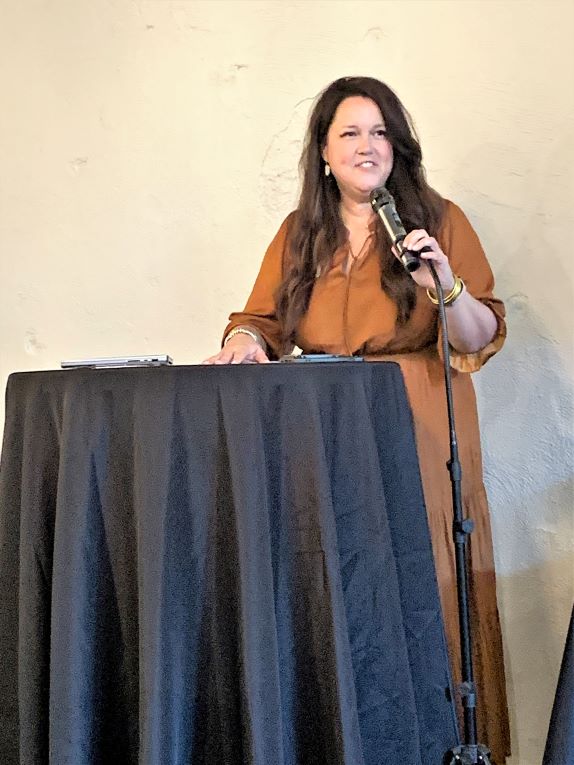
Glass also offered thanks to Moseley for helping in any and every way possible, as well as to HCUW Executive Secretary Susan Berning, for approaching each campaign, meeting and person donating their time and/or funds to HCUW with an encouraging servant’s heart; the United Way Budget and Allocations Committee for their willingness to hang on through the 2-day emotional ride of hearing requests from nonprofits for funding and with true servant hearts, advocating for the nonprofits; to all past and present UW chairs, officers, board and committee members for the time they gave to make HCUW a continued success since 1955.
Acknowledged as this year’s Board of Directors were Chuck Askins, Emily Glass, Beverley Owens, Wade Bartley, Charlotte Henderson, Bill Owens, Larry Crowson, Mike Horne, Dinh Tran, Debra Evans, Sherry McGraw, Hillary Young, Markeda Fisher and Kristy Mosely.
The HCUW Budget and Allocations Committee includes David Burns, Ashley Crump, Emily Glass, Tommy Harrison, Charlotte Henderson, Mike Horne, Lindsey Johnson and Kristy Moseley.
The 2022-2023 HCUW officers offered thanks to Alliance Bank for sponsoring the lunch, Birthwright’s Barbecue for catering it, Latsons.com team for campaign materials, Lonnie Fox for sound equipment, Texas A&M AgriLife Extension for allowing HCUW to hold regular meetings at the office, The Venue at 219 for hosting the lunch and VOSH Graphix for compiling the campaign video shown at the kickoffs and available to show others about HCUW.
History of Giving

Glass asked fifth generation Hopkins County resident, local historian, longtime HCUW supporter and Sulphur Springs Mayor Pro Tem John Seller to be give the keynote address at the the Lead Donor/CEO Luncheon Wednesday. In addition to contributing, Sellers has served in a number of leadership positions with United Way, including as HCUW chairman 14 years ago, then president.
Sellers noted the 1950s was a pivotal time in local history. The local hospital was opened in 1949, with the physicians operating a few private hospitals closing their doors and going to work at the hospital, a show of unity and support in the community.
The city got its first dial telephone in the fall of 1954; Interstate 30, known then as the Highway 67 bypass, was opened, providing straight travel to Dallas, without any traffic lights; a zoning ordinance was adopted in 1956 by the City of Sulphur Springs was implemented ahead of a new dairy processing plant; a pledge was made to construct a new lake — Century Lake and get it done in a decade. Three counties created the Sulphur River Municipal Water District. During that era, night watchmen got their first walkie-talkie radios, according to Sellers.
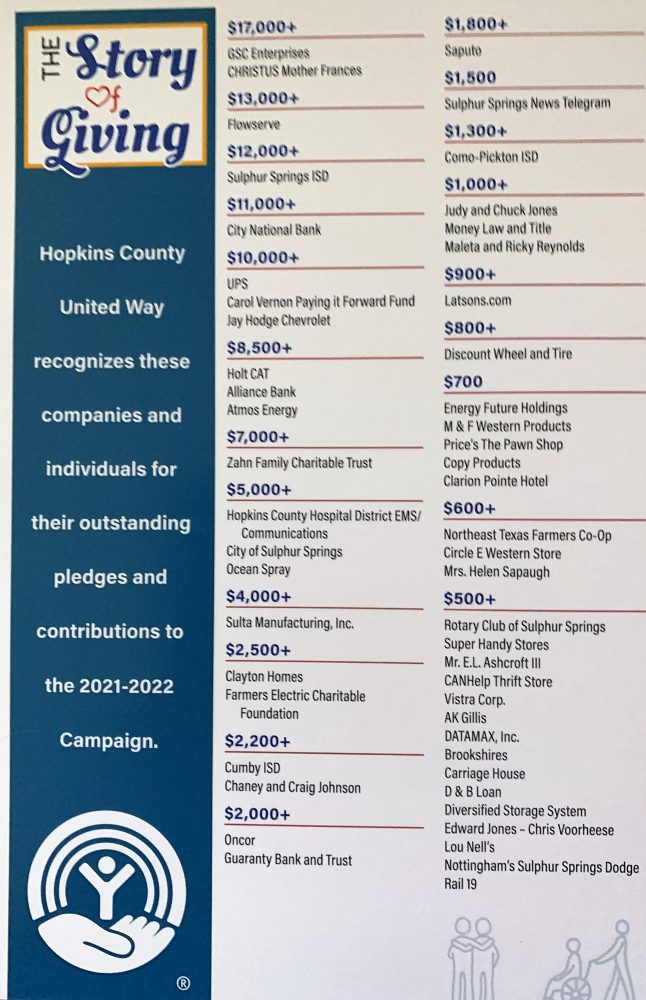
The history of giving United Way goes back 67 years, to the organization’s start in 1955 as the United Fund, thanks to the work of a group of civic leaders which included KSST’s Bill Bradford and the local newspaper publisher. After research into the United Fund and approval from local businesses, the organization was formed, a way to raise more money to do the most good for so many different organizations all at one time.
The first year, the United Fund set a goal to raise $29,500 in one week (the equivalent of raising about $300,000 today) to benefit 8 local agencies in October 1955. A kickoff dinner was held Oct. 6, 1955, with a victory drive planned on Oct. 13. The local newspaper ran a front page editorial about the United Fund.
Community members were challenged to donate the equivalent of just one day’s worth of pay to help others in the community. In North Hopkins 25 rose to the challenge, and all total 108 teachers responded, contributing a day’s pay to the United Fund.
The group ended up expanding the campaign to Nov. 1, but in the end the 24 teams consisting of 350 solicitors raised $200 over the projected goal, according to Sellers, who gained access to Bradford’s notes on the topic when he asked for help in researching HCUW’s history prior to accepting the office of HCUW campaign chair 14 years ago.
“They stayed after it and by Nov. 1 they were over by $200. It was the beginning to a great start and a great tradition,” Sellers said.
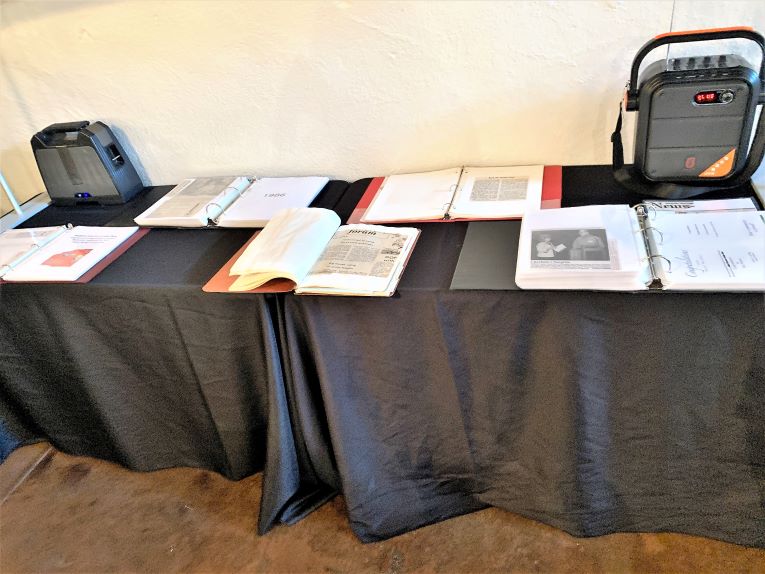
A New Challenge
Sellers challenges those who wonder why give to United Way to keep in mind the parable about the Good Samaritan. Two passed the beaten, bloodied naked man. However, the enemy of the Jew, a Samaritan, stopped. Instead of asking, “‘What would it mean to me if I help him,'” the Samaritan asked ‘What would happed to him if I didn’t help him?’
Only 1% of the $150,000 campaign goal leaves Hopkins County, the amount paid to United Way Worldwide for involvement in the cooperative organization. The rest remains in the community to help people of all ages and walks of life, from those who need help with basic needs, emergency assistance, dealing with trauma from abuse or trauma, in need of therapy for disability or disabling situations, education and intervention and enrichment through the following 18 local agencies HCUW has allocated funding from the 2022-2023 campaign.

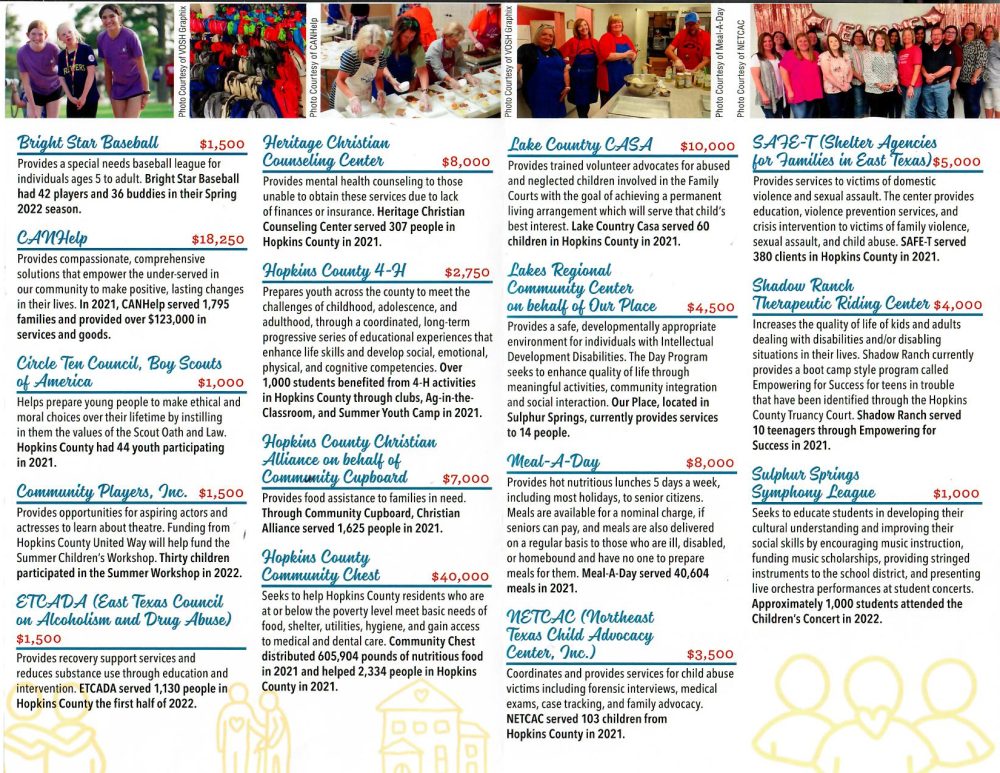
Additional Information
HCUW volunteers last week began collecting packets, which have begun going out into the community. Any new business that has not been contacted and would like to contribute or more information about HCUW is encouraged to contact Emily Glass or Kristy Landers Moseley, any campaign worker, or calling Executive Secretary Susan Berning at Campaign Headquarters at 903-243-4066, to check out the United Way website or Facebook page, or mail donations to HCUW with a name and address to campaign HQ at PO Box 735, Sulphur Springs, TX 75482.
Donations are also accepted via PayPal on the HCUW Facebook page and website, https://hcuw.org/; or credit card via the United Way Worlwide website. Queries may also be sent to [email protected].
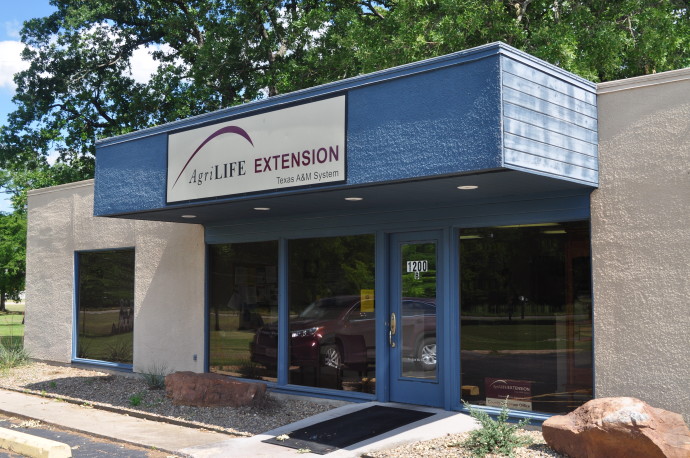
Upcoming
Report meetings will take place at the Texas A&M AgriLife Extension office beginning at 9 a.m. on the following dates:
- Tuesday, Oct. 4
- Tuesday, Oct. 11
- Tuesday, Oct. 18
- Tuesday, Oct. 25
- Tuesday, Nov. 1
- Wednesday, Nov. 9
Getting Back To Family

By Johanna Hicks, Extension Agent, Family and Community Health Agent, Hopkins County,
I have often said that strong marriages make strong families and strong families make strong communities. We must remember that today’s youth are tomorrow’s leaders. Somewhere along the way, Americans have lost the idea of putting emphasis on strong relationships. The violence, confusion, misbehaviors, and lack of respect have caused major problems in schools and communities. Teachers are exhausted at the end of the day because many students are disrespectful and often belligerent. Law enforcement officials are being stretched to the breaking point, and families are crumbling.
There is not an easy solution, but a stepping-stone to helping improve the chaos is to start with the home. Parents should teach their children right from wrong, respect for authority, and responsibility, all while setting a good example. Being a parent is simultaneously one of the most challenging and rewarding experiences that we will ever have. There will be many joys and frustrations because children don’t come with an instruction manual. We all make mistakes when it comes to parenting, but learning from those mistakes is crucial.
The foundation for children’s successful development is established early in life. From birth, children interact with others in a variety of contexts that shape who they are as individuals. Parents, caregivers, teachers, peers, extended family, community, media, heredity, and environment all influence a child’s growth and development. However, parents serve as the primary influence in their lives. Take them to church, play with them, teach them about good character, and most of all, love them.
For teens, sports and after-school activities are back in full swing and this is a busy time of year! One of the best ways to communicate with your teen is through food. It can be stressful for families to figure out how to plan, prepare, and eat meals together, but family time is so important. One particular manufacturer of dinner napkins had a brilliant idea. Printed on each napkin is a discussion starter for mealtime. These include: “What was your favorite thing about today?” “If you could make a difference for someone, what would you do?”, etc. Conversations with your children and teens will lead to better understanding of their feelings, fears, and needs.
The USDA Food and Nutrition Service has put together some suggestions to make preparing and eating family meals easier:
- Spend some time on the weekend planning out meals for the week. Use quick, simple recipes that won’t take up valuable family time.
- Schedules don’t align for dinner? Try having breakfast together instead. Enjoy your morning coffee with the kids as they eat breakfast instead of drinking it at work.
- When you can be home together, turn off the TV, move away from devices, and spend time focused on conversations.
Keep in mind what works for some families might not work for others. Whether it is leftovers eaten together on the couch or a formal, cooked meal, it all counts! The research is clear that preparing and eating meals together can improve family connections, communications, and create lasting memories. A little extra planning may be worth a lot in the long run!
49th Annual Christmas Joys
This is a popular event! Scheduled for Monday, November 7, the program will feature presentations on gift-giving, decorating, crafts, recipes, and more for the holidays. As of this writing, the 1:30 session is FULL, but several seats remain for the 5:30 p.m. session. If you are interested in attending, please call the Hopkins County Extension Office at 903-885-3443. We must have a name and phone number for each seat reserved. The cost is $5 payable at the door. Children under 10 are free. Those attending will receive a swag bag and a booklet of all the recipes and instructions for things demonstrated.
Closing Thought
Having a child fall asleep in your arms is one of the most peaceful feelings in the world. – Andy Rooney
Contact Johanna Hicks, B.S., M.Ed., Texas A&M AgriLife Extension Family & Community Health Agent at the Hopkins County Extension Office, P.O. Box 518, 1200-B West Houston St., Sulphur Springs, TX 75483; 903-885-3443; or [email protected]
TDI Notice For Consumers With FedNat Insurance Policies

FedNat, a Florida insurance company licensed in Texas, was ordered by a Florida court to end its operations. FedNat policies, except for federal flood policies, will be cancelled effective 12:01 a.m. October 27, 2022, unless otherwise terminated prior to that date.
There are about 3,700 FedNat Insurance policyholders in Texas. Texas Department of Insurance (TDI) recommends those who have a policy with FedNat Insurance to contact their insurance agent as soon as possible to arrange for alternate coverage.
The Texas Property and Casualty Insurance Guaranty Association (TPCIGA) will refund Texas FedNat policyholders’ unearned premium (premium paid for the period after the policy is canceled).
TPCIGA will be responsible for paying claims for unearned premium. Texas customers/policyholders don’t have to file their own claim. The Receiver will notify TPCIGA of the policyholder’s unearned premium claim.
TPCIGA was created by the Texas Legislature to pay property and casualty claims if an insurance company fails. This includes refunding unearned premium payments to policyholders. Learn more about TPCIGA on their About Us webpage.
People living in another state can find their state’s guaranty association by going to the National Conference of Insurance Guaranty Funds’ website.
To help protect Texas coastal insurance consumers, TDI issued an emergency rule earlier this year that removes certain barriers to getting wind and hail coverage through the Texas Windstorm Insurance Association (TWIA).
About 1,000 FedNat Insurance policyholders live in either TWIA’s Designated Catastrophe Area or Harris County, TDI reported Sept. 28, 2022.
Additional Resources From TDI
- FAQ for all FedNat policyholders
- Guidance for FedNat Insurance policyholders who live along the Texas coast
- Emergency rule adoption order (PDF)
- TWIA overview (PDF)
- What you need to know about windstorm inspections
Additional questions on this topic may be directed to TDI at 1-800-252-3439. Contact the Texas Property and Casualty Insurance Guaranty Association by phone at 512-345-9335 or toll-free 800-856-0298; fax at 512-345-9341; by email at [email protected]; or mail to TPCIGA, 9120 Burnet Road, Austin, TX 78758.
Meet & Greet Rally Hosted For Mike Collier, Democratic Candidate For Lt. Governor
A meet and greet rally was hosted Tuesday at Sulphur Springs Country Club for Mike Collier, Democratic candidate for lieutenant governor.
Democrats from Hopkins and surrounding counties attended, including Wood, Hunt, Lamar, Titus, Rains and Rockwall counties.

One woman from Hunt County brought to the Sept. 27, 2022 rally a pooch she introducted as ” the official canine mascot of Hunt County Democratic Party.” She said “Bitty” met Beto O’Rourke at the 2022 Texas State Democratic Convention and gave his approval, wholeheartedly endorsing the state candidate. She offered buttons promoting “Bitty for Beto — Beto For All,” in English and Spanish for a $5 donation, which serve to not only spread awareness for the candidate but also the Hunt County Democratic Party.
Bill Brannon introduced notable past and present dignitaries and guests, including former Congressman Jim Chapman and former State Rep. Mark Homer. Sulphur Springs High School graduate Kendall Scudder, Vice Chair for Finance of the Texas Democratic Party, also was present.
“We are living in perilous times. We are living in dangerous times in America. We are living are living in a country that we can literally say without exaggerating that democracy is absolutely on the line, and it’s on the line in 44 days,” Chapman said, referring to the Nov. 8 election.
The former congressman said there are people that don’t believe the last election was conducted properly and, thus, don’t believe Biden was rightfully elected. Chapman said if the more than 200 on ballots around the state who believe that way are elected in 2022 and 2024, “it won’t matter how we vote, because they’re going to go the other direction as long as the other direction is putting a Republican in office.”
“You don’t have to go very far into the weeds to see how real it is, how dangerous it is and how we have to be so careful and work so hard to protect what 246 years ago our founding Fathers did when they created the Constitution,” Chapman said. “It’s serious. It’s not just about getting someone who lines up with someone else on our particular issues. It’s about whether we’re going to maintain American Democracy or not. That’s how serious it is.”
Chapman said Texas is fortunate to have Mike Collier as a Democratic candidate who will go up against those opposed to those values, and emphasized the important need to get everyone out to vote.
He thanked everyone for attending and Brannon for all he’s done, concluding encouraging all to roll up their sleeves to help get their candidates to the finish line.
Former State Representative Mark Homer noted a change in Texas in 2003, when the majority of elected officials in the House were Republican. He said even then, people like Bill Ratliff tried to work together in the House. As things progressed, Homer said, things got “a little meaner, a little uglier, further separated.” He said while 2010 at the time was one of the worst moments of his life because he was not reelected to office, it turned out to be “probably one of the best things that ever happened to me.” He wondered at people who had previously supported him suddenly changing political parties to no longer identify as Democrats but as Republicans. He said it’s a sad state of affairs that some candidates are no longer out to just beat their opponent in office but to destroy them. That, Homer said, is a sad state of what the country has become.
“So now we have a legitimate, strong change to make a change back to full democratic beliefs, or at least start getting us back to toward the middle, where we can look at our opponent friends and say, “Hey, let’s work together.’ Compromise would be a good word again, and talk about it. That real, legitimate shot today is Mike Collier,” Homer said.
Homer said, to him, the first office that “has to change” is the lieutenant governor’s office. Electing Mike Collier would be a step in the right direction.
“So, I am here asking you as friends, as someone who supported me for 12 years… to find that effort and do the same for Mike Collier,” Homer said.
Homer said the vote in November is “the most important we’ll ever take” to “save our country.” He noted the vote is “that important,” and encouraged everyone to get their eligible young relatives to vote, to not take no for an answer when it comes to getting others to go vote.
Collier said he first ran for Comptroller 9 years ago, after learning the official was stepping down and no Democratic candidate came forward, none willing to risk their political career in running for an office the party did not think their candidate could be won. He was angry with the way taxes were allocated, with funding for public schools going down. So, he put his name in for the position, with no political career, so far, to lose. Bill Brannon drove down to talk to him, and despite his lack of lack or experience, backing and campaign funding, Brannon agreed to back him.
He was defeated in his bid for Comptroller 9 years ago, but said with 44 days left to go in the 2022 campaign for the lieutenant governor he is no where near running out of energy. He thanked Brannon for being a coach, mentor and friend every step of the way.
“I ran against Dan Patrick 4 years ago and came close. The reason for the rematch is we did really, really well in rural Texas because we had cross-over votes,” Collier said, noting that while overall Beto O’Rourke got more votes than him, in a rural Texas “which is dominated by Republican politics, he got more votes that O’Rourke. “The only way to explain that is Republicans crossing over to vote for me because they don’t like Dan Patrick and they know how important it is to have a lieutenant governor who believes in democracy. I believe we need those votes to win. I know we need to win. That’s the reason for the rematch.”
Collier said, about 6 weeks ago, three prominent Republicans crossed party lines to endorse him, and he believes “there will be others” who do so as well.
“What’s happening is, this campaign feels like it’s taking shape. It really is beginning to feel like a nonpartisan movement to change the politics in this state, which we must do. And, I am so honored to be at the center of this,” Collier said. “I can tell you, it’s just the tip of the iceberg.”
He said the very best part is that not one Republican who has said I’m going to help you, publicly or not, has has disagreed with any plank on my platform.” He feels the majority of the state will agree as well.
Collier said his platform is very simple: improve public education for all, lower property taxes and give more funding to schools. He said expanding Medicaid and healthcare, and fixing the power grid are also important.
It starts with public education, having great schools for all children, to full the moral obligation so that every young person receives the education be successful, Collier said. In order to have great public schools, teachers have to be excited about being teachers and the decisions they make. Talking to educators, they say smaller class sizes are needed to effectively teach children, special education support, counselors are needed, stop teaching to the test, paying teachers properly so they don’t regret their decision to become teachers, and retirement security for teachers, the Democratic candidate said.
“The hardest part is the money,” Collier said. “As a CPA, here’s the deal, if you’re paying property taxes because you own a home, you’re being ripped off. Your property taxes keep going up and up and up, and your money is not going into public education. The reason why taxes keep going up is state fiscal policy. The state puts in less, so you put more and you’re not getting more. It just isn’t right.”
Collier believes the solution is to “close the corporate loopholes” that prevent hte money from flowing into the treasury.
The Democratic lieutenant governor candidate said his platform also includes expanding Medicaid, which his sources are telling him Republican except his opponent are in favor of. He believes expanding that will help with the problem of small hospitals closing in small towns and rural Texas.
He believes in protecting health rights and said water issues, expanding broadband internet connectivity and transportation and infrastructure are also big issues in Texas that need to be addressed.
Tickets For 53rd Annual Hopkins County Stew Festival Now On Sale For $8 Each Or 4 For $28
By Butch Burney, CEO/President, Hopkins County Chamber of Commerce, [email protected]
Tickets for this year’s 53rd Annual Hopkins County Stew Festival, sponsored by Alliance Bank, are on sale at the Chamber of Commerce office, local banks and online!
This year, tickets are $8 each or four tickets for $28. You can purchase them at Alliance Bank locations, City National Bank locations, Texas Heritage National Bank and Pilgrim Bank, or at the Chamber office, 110 Main St. You can also purchase them online at HopkinsChamber.org.
Quart tickets are $15 this year. They can only be purchased at the Chamber office or the day of the stew, which is Saturday, Oct. 22.

Stew Cook Registration
If you have cooked stew in the past or want to for the first time, now is the time to register for Stew Fest, presented by Alliance Bank. Friday night activities, hosted by Bob Evans Foods, will be going on the night before at Buford Park.

The Friday night festivities include the appetizer contest and a concert by Dubb and the Love Machines following the home football game.
To register for a cook site, go online to the Chamber’s website at HopkinsChamber.org/stewcooks, email [email protected] or call 903-885-6515. The cost to enter is $100 per stew pot, with $150 coming from the sponsor to pay for ingredients.
Volunteer Opportunity
If a person or group would like to volunteer to work in one of the service tents at the Stew Festival, please contact me at [email protected] or by calling 903-885-6515. Volunteers can help from 9 a.m. to about 12:15 p.m.
Ribeye Roundup

If you’re looking for a great steak, you don’t want to miss the Cattleman’s Classic and Ribeye Roundup on Saturday, Oct. 1, on the downtown plaza.
The event features a steak cook-off which will include an expected 40-plus cook teams, educational trade show, free Bobby Irwin concert and more.
You can also get a blue Ribeye Roundup T-shirt for just $14 at the Chamber of Commerce, 110 Main St. Come by to pick one up!
Main Street Uncorked
Main Street Uncorked Wine and Music Festival is ready to go from 1-7 p.m. Saturday, Oct. 8, downtown. There will be wine samples from some of the best Texas wineries, local vendors and musical artists including Jeb Brooks Band and Twisted Whisky.
Tickets are available for $10 online at MainStreetUncorked2022.eventbrite.com. Tickets are $15 at the door.

Main Street Theatre

This weekend – Friday, Sept. 30 and Saturday, Oct. 1 – Main Street Theatre presents two one-night only shows. Advance tickets for both events are now available at CommunityPlayersInc.com for $15. Tickets at the door are $20.
On Friday, jazz vocalist Carolyn Jones will be in concert, accompanied by pianist Brad Williams. The show will include an evening of stories and standards.
On Saturday, Enola Gay sits down with Leah Conner to talk about the importance of live music and the work the Conner family is doing to help beat cancer by producing and organizing the Texafied Jamfest in Hopkins County.
A portion of the evening’s proceeds will be donated to MD Anderson Cancer Center – Pediatric Cancer Research and Treatment.
Castillo-Zavala Sentenced On Manslaughter Charge
Jaime Antoni Castillo-Zavala was sentenced last week on a March 18, 2022 manslaughter charge, according to sheriff’s and court reports.

The 38-year-old man was sentenced Sept. 20 to 10 years in prison , a sentence that was suspended, and the Saltillo man was placed on 10 years of probation. Castillo-Zavala, however, will be required to serve 180 days in jail as a condition of that probation, according to Assistant District Attorney Zachary Blackmon.
Castillo-Zavala (who is also known by Jaime Zavala Soto, Jaime Zavala-Soto, Jaime Soto-Zavala, Jaime Savala Soto and Jaime Antonio Castillo-Zavala) was taken into custody Sept. 20 and held in jail until he was outfitted Sept. 26 with a SCRAM device to be worn to monitor alcohol consumption by analyzing sweat. He was released on furlough, giving him 30 days to get his affairs in order. After the 30 days, he will once again be place into custody to serve the remainder of the mandatory 180-day sentence, according to Blackmon.
After the 180 days in custody, Castillo-Zavala will be required to go to a substance abuse felony punishment facility (SAFPF) to complete a substance abuse rehabilitation program run by Texas Department of Criminal Justice. The incarceration rehab program is 6 months long, followed by a 3-month aftercare program, which can be as restrictive as a halfway house or as lenient as outpatient rehab. The aftercare would be determined by assessing the defendant’s situation during the 6 month program, according to the ADA.
After Castillo-Zavala is released from SAFPF, Castillo-Zavala will have to complete 500 hours of community service. He also was fined $5,000, the ADA reported.
If you have an emergency, dial 9-1-1
The Hopkins County Sheriff’s Office is located at 298 Rosemont Sulphur Springs, TX 75482. You can reach them for non-emergency matters at (903) 438-4040.
Information About the Preparatory CDL Truck Driving Course at the Paris Junior College-Sulphur Springs Center
PREPARATORY CDL COURSE
PJC-Sulphur Springs Center Instructor Mike Minihan, standing, explains one of the topics to his students in the preparatory CDL truck driving class. The students are, from left, Ricardo Yanez, David Tilley and David Kemp. Back: Miranda Hodges and Fred Gilstrap. The class is part of the adult education program at the campus. Call 903-885-1232 for more information about the course.

Paris Junior College — located in Paris, Texas, about 100 miles northeast of Dallas — has been a part of the Lamar County community since 1924.
Paris Junior College offers Associate in Arts, Associate in Science and Associate in Applied Science degrees, as well as Certificates of Proficiency in technical/workforce fields. The college has expanded its academic curriculum through the years to encourage associate degree and university transfer candidates. Since establishing its first vocational program — jewelry and watchmaking in 1942 — the college has been aggressive in adding technical/workforce programs that will benefit students entering the workforce.
The campus of 54 tree-shaded acres includes 20 major buildings and residence halls and provides students a unique and pleasant environment for learning.
Paris Junior College also operates centers in Sulphur Springs, Texas, and in Greenville, Texas.
Vision
To be the educational provider of choice for the region.
Mission
Paris Junior College is a comprehensive community college serving the region’s educational and training needs while strengthening the economic, social and cultural life of our diverse community.



